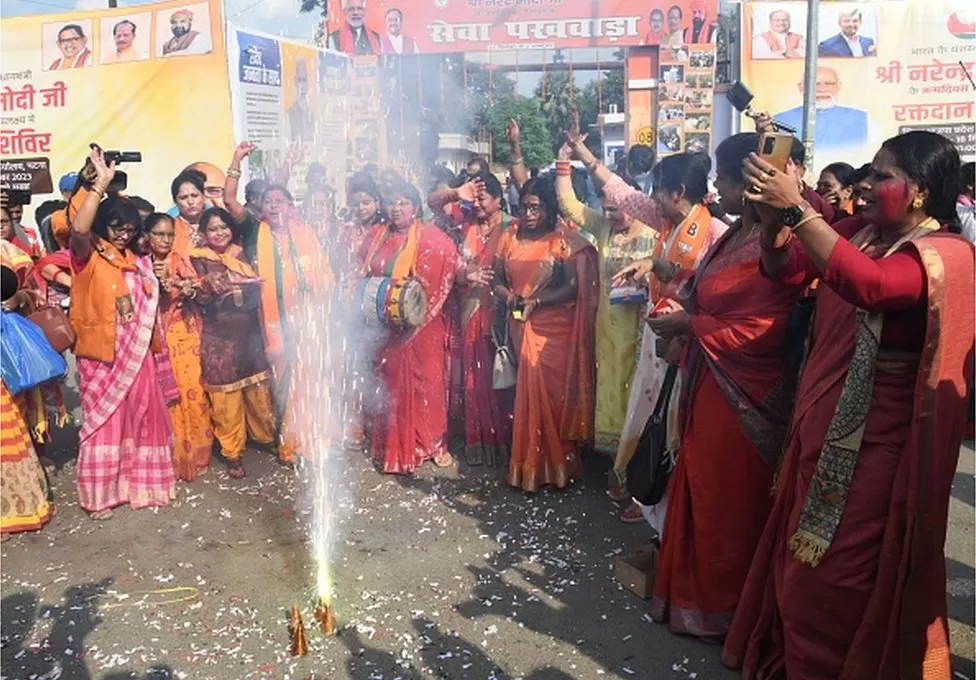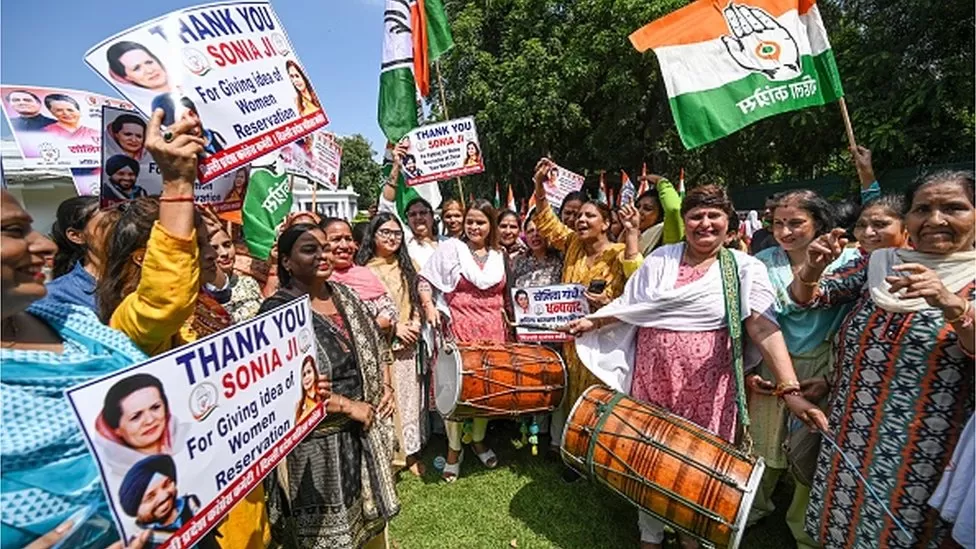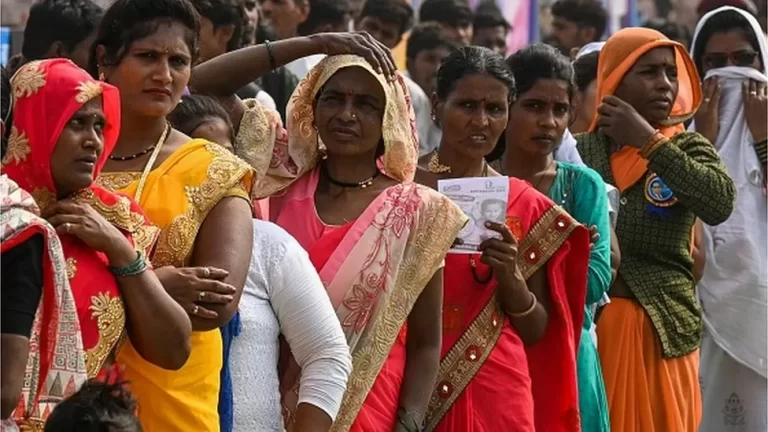The Indian parliament has passed a bill that guarantees a third of seats for women in the lower house of parliament and state assemblies.
But the country is a long way away from seeing more women elected to its legislatures soon since it will be implemented only after India completes the next census and an exercise to redraw the boundaries of constituencies – the complicated processes are expected to take several years.
On Wednesday, the Lok Sabha, or the lower house of parliament, approved the Nari Shakti Vandan Adhiniyam (which loosely translates from Hindi to Saluting Women Power Act) almost unanimously – with 454 of the 456 MPs present voting in favour.
On Thursday, the upper house, or the Rajya Sabha, debated the bill and passed it unanimously. It now requires the president's signature, but analysts say that is a mere formality and the bill is “tantalisingly close” to becoming law.
The passage of the bill, which has been in the works for over a quarter of a century now, has been described as “historic” by the government. Prime Minister Narendra Modi has said it will “boost women empowerment and enable greater participation of women in our political process”.
But opposition politicians have accused the government of “betraying the hopes of millions of Indian women and girls” by keeping the timeline “vague”. Demanding its immediate implementation, former Congress president Sonia Gandhi asked: “How many years will they have to wait – two, four, eight?”
What does the bill say?
The bill reserves one-third of all seats for women in the Lok Sabha, state assemblies and also in the capital, Delhi, which is a federally-administered territory but has an elected assembly.
The law will also apply to the seats that are already reserved for some of India's most disadvantaged communities known as Scheduled Castes and Scheduled Tribes. In the 545-member Lok Sabha, 131 seats are reserved for these two groups and add up to thousands in state assemblies.
The reservation, once implemented, will be for a period of 15 years, but it could be extended by parliament. A law made by parliament will decide which seats will be reserved for women – and they will be rotated after every few years.
India's ‘dismal' record
India boasts a history of powerful women in politics, both in the past and the present. The country had a female prime minister as early as in 1966 and some of the biggest political parties are headed by women.
Female chief ministers have run some of India's largest states and several women helm powerful ministries at federal and state levels. The country has also had two female heads of states, including current President Droupadi Murmu.
A Pew Research Center survey last year saw most Indians saying that “women and men make equally good political leaders”. And data shows that as many women voted in the last general election as men. But the representation of women in Indian parliament and its state legislatures has often been described as “dismal” and data shows it remains poor.
Tushar Chakrabarty, senior analyst at non-profit PRS Legislative Research, says the first Lok Sabha in 1952 had 5% female MPs and though it rose to 15% in 2019 elections, it continues to be quite low. In legislative assemblies, the PRS data shows it's even poorer at about 9%.

“We have seen that the numbers have not increased organically. And if women are not adequately represented in legislatures, it affects their ability to influence policy-making,” he says.
India also needs to address this gender disparity since it is a signatory to the UN Convention on the Elimination of All Forms of Discrimination against Women which includes equal political rights for them, he adds.
27 years in the making
The need to have more women in position of political power in India has been keenly debated for decades. Exactly 30 years back, the parliament amended the constitution to reserve 33% seats for women in village councils and municipal corporations in urban areas.
A similar bill to reserve seats in the parliament and state assemblies was first proposed in 1996 by the then federal government, led by Prime Minister HD Deve Gowda. It was reintroduced in parliament in 1998, 1999 and again in 2008.
Each time, it fell through because of opposition from many political parties, including from BJP MPs. As the latest bill, tabled in parliament by Mr Modi's government, borrows heavily from its predecessor, his Bharatiya Janata Party (BJP) and the opposition Congress have been claiming credit for it.
The debate in parliament
Speakers from the treasury benches in both houses applauded the prime minister for seeing the bill through in the parliament.
“Women's security, respect, equal participation have been the life force of PM Modi's government,” Home Minister Amit Shah said. Appealing to all parties to support it, he said the bill was a “good start” and added that if needed, it could be improved later.
The reservation, once implemented, will be for a period of 15 years, but it could be extended by parliament. A law made by parliament will decide which seats will be reserved for women – and they will be rotated after every few years.
India's ‘dismal' record
India boasts a history of powerful women in politics, both in the past and the present. The country had a female prime minister as early as in 1966 and some of the biggest political parties are headed by women.
Female chief ministers have run some of India's largest states and several women helm powerful ministries at federal and state levels. The country has also had two female heads of states, including current President Droupadi Murmu.
A Pew Research Center survey last year saw most Indians saying that “women and men make equally good political leaders”. And data shows that as many women voted in the last general election as men. But the representation of women in Indian parliament and its state legislatures has often been described as “dismal” and data shows it remains poor.
Tushar Chakrabarty, senior analyst at non-profit PRS Legislative Research, says the first Lok Sabha in 1952 had 5% female MPs and though it rose to 15% in 2019 elections, it continues to be quite low. In legislative assemblies, the PRS data shows it's even poorer at about 9%.
“We have seen that the numbers have not increased organically. And if women are not adequately represented in legislatures, it affects their ability to influence policy-making,” he says.
India also needs to address this gender disparity since it is a signatory to the UN Convention on the Elimination of All Forms of Discrimination against Women which includes equal political rights for them, he adds.
27 years in the making
The need to have more women in position of political power in India has been keenly debated for decades. Exactly 30 years back, the parliament amended the constitution to reserve 33% seats for women in village councils and municipal corporations in urban areas.
A similar bill to reserve seats in the parliament and state assemblies was first proposed in 1996 by the then federal government, led by Prime Minister HD Deve Gowda. It was reintroduced in parliament in 1998, 1999 and again in 2008.

Each time, it fell through because of opposition from many political parties, including from BJP MPs. As the latest bill, tabled in parliament by Mr Modi's government, borrows heavily from its predecessor, his Bharatiya Janata Party (BJP) and the opposition Congress have been claiming credit for it.
The debate in parliament
Speakers from the treasury benches in both houses applauded the prime minister for seeing the bill through in the parliament.
“Women's security, respect, equal participation have been the life force of PM Modi's government,” Home Minister Amit Shah said. Appealing to all parties to support it, he said the bill was a “good start” and added that if needed, it could be improved later.
— CutC by bbc.com


